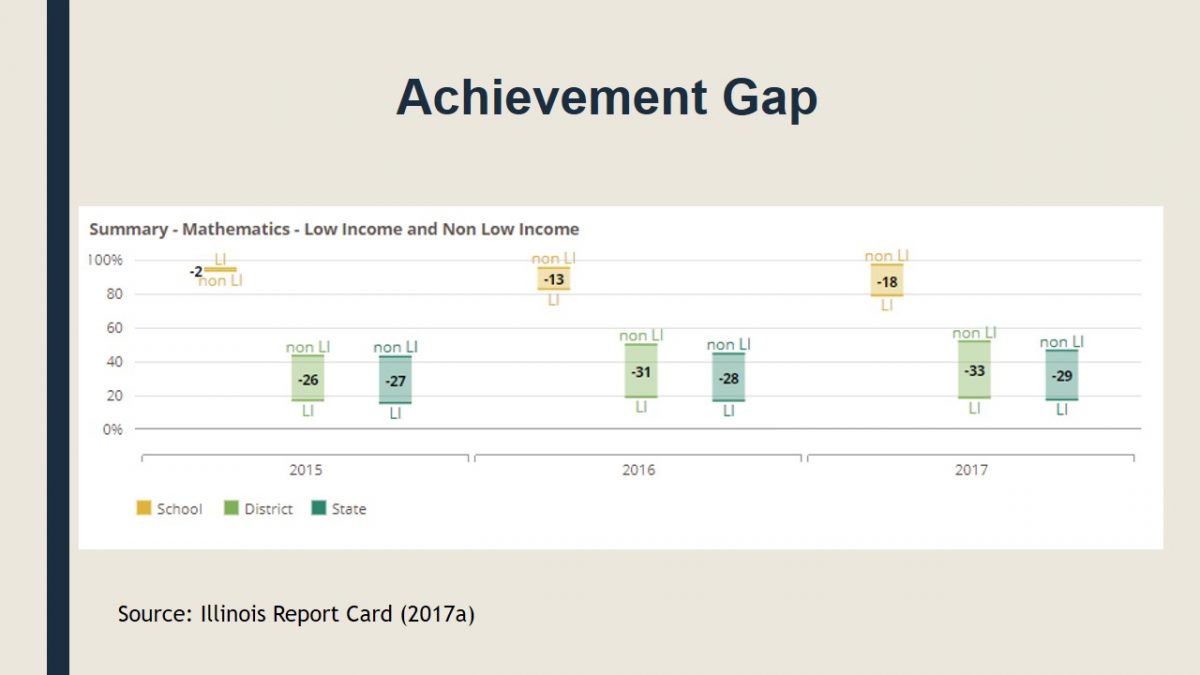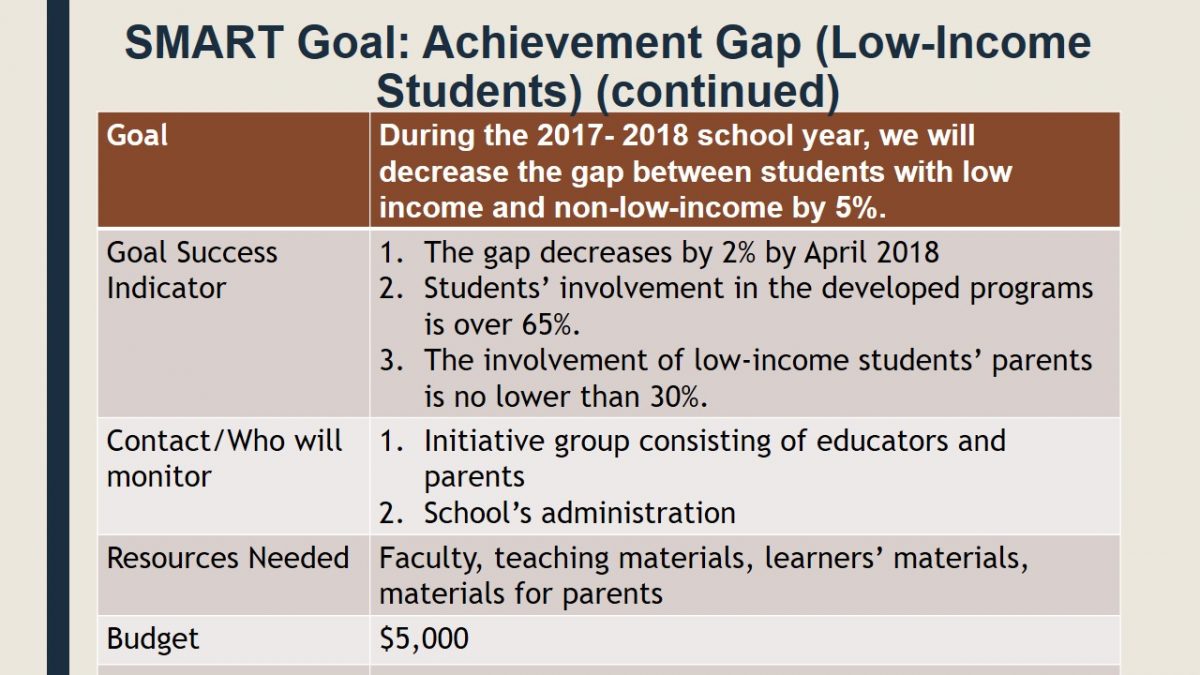Key Information
- Target Audience:
- Principal Katie Magnuson;
- Assistant Principal Nicole Spicer;
- Faculty;
- Focus:
- Students’ performance;
- Current Situation:
- Initiating.
This presentation focuses on enhancing the learning performance of Skinner North Elementary School students and specifying goals for the 2017-2018 school year (Illinois Report Card, 2017c). The key characteristics of the identified school include high engagement rates, relatively high average learning performance, and good discipline. In order to support the focal indicators that were presented in detail in the data picture of the school, it is essential to formulate strategic goals and outline an action plan. At this point, it is necessary to note that the current situation associated with this plan can be described as initiating as the administration has come up with major strategic goals and budgets, but there is still no exact plan in place. Whereas, the development of programs to address the established goals is encouraged.

District Goals
- To improve standardized test scores and local assessments scores especially as it pertains to math, English (reading/writing), and science.
- To monitor student academic progress in order to improve the graduation rate.
- To ensure that all District 215 courses are aligned to the New Illinois Learning Standards and that on-going evaluation of that curriculum occurs with revisions as needed.
- To create and monitor a Four Year Academic Plan for every student to maximize post-secondary opportunities.
- To increase student, family, and community engagement.
- To produce technology literate (digital literacy) students who can access information via multiple platforms.

Achievement Gap
The school is characterized by its students’ good performance. The students’ scores range between 80 and 100%, which is far beyond the state or district average. These promising data still reveal an alarming trend associated with different opportunities for different groups. For instance, the achievement gap between low-income and non-low-income students increased significantly during past three years. For instance, it was 13% in 2016, but it reached 18% in 2017 (Illinois Report Card, 2017a). As far as another vulnerable group is concerned, students receiving individualized education programs also have poorer achievements as compared to the students who do not receive IEPs. The achievement gap decreased as compared with the results of 2016, but it is higher than the figures of 2015.

Student Demographic Data
To evaluate the situation and develop the most appropriate intervention, it is essential to analyze certain demographic data. Importantly, the rates of low-income students and those receiving IEPs are quite small. For instance, 12.5% of the student population is constituted by low-income students while 4% of students get IEPs (Illinois Report Card, 2017b; Illinois Report Card, 2017d). It is possible to assume that the small number of the target population can be associated with a comparatively small amount of the needed resources. Moreover, the number of students who will participate in the program is quite small, so it can be easier to take into account various peculiarities of the students involved in the intervention. However, it is necessary to consider possible fluctuations in the rate of the target population, which may translate in the increase of the budget as more resources may be needed.

SMART Goal: Achievement Gap (Low-Income Students)
To decrease the gap between low-income and non-lo-income students’ achievement in reading and Mathematics, it is necessary to develop and implement programs aimed at direct training of the target population, supervising of peer-based coaching, and parental involvement increase. The programs should be state funded. To develop the mentioned programs, it is necessary to use such professional development strategies as networking and facilitated discussion groups (Jensen, 2013). This format is beneficial as it involves sharing ideas and experiences that are pivotal for the development of such interventions. The implementation of the programs will require the use of mentoring, peer coaching, and networking. The programs will not require specific skills that are new to teachers. However, peer coaching and mentoring may help some educators to be more effective when implementing the designed interventions.


SMART Goal: Achievement Gap (Students with IEPS)
To improve the performance of students with IEPS, it is possible to develop programs that will address the needs of this population. The provision of extended learning time for students with IEPS is a part of the intervention. The programs will also involve additional courses in Mathematics and Reading as well as training sessions for the target population with. These sessions will involve high-achieving and low-income students, which can facilitate the collaboration among students. Training sessions for parents will help parents address their children’s needs (Worcel, 2016). To develop the programs, such strategies as networking and facilitated discussion groups will be used. To implement the intervention, direct training, peer coaching, and mentoring will be used to ensure the faculty’s ability to achieve the established goals. Networking can also be used to facilitate the process of knowledge sharing.


Key Points
Major aspects to consider:
- Teachers’ training.
- Family engagement.
- Community engagement.
When developing the programs to achieve the established goals, it is vital to take into account a number of points. First, teachers involved in the project will need certain training. The training should include the following issues teachers’ awareness concerning the peculiarities of the target population, knowledge and skills to assist the students involved in the intervention. Teachers should understand the reasons why low-income students perform poorly (Jensen, 2013). Some areas to pay attention to include linguistic and cognitive issues, possible family issues, as well as emotional and psychological issues these students face. It is also critical to increase the engagement of families and the entire community. Worcel (2016) stresses that family engagement is important as familial support and commitment encourage students. Moreover, parents change their attitudes towards their children’s issues and become more committed to helping them in their academic life. The community has various resources that can be used to help the target population perform better. Therefore, it is important to develop programs that include activities aimed at developing awareness in different stakeholders. The stakeholders (including teachers, students, administrators, families, community, and so on) should collaborate and communicate closely.

Conclusion
- Target population: low-income students, IEP students.
- Goals: Decreased achievement gap.
- Programs: faculty training, the engagement of families and community.
- Outcomes: the development of the community, educational system.
In conclusion, it is necessary to note that the target population includes low-income and IEP students. The number of these people is comparatively small, which can help researchers develop cost-effective interventions. The major goal is to decrease achievement gaps by 5%. The programs aimed at achieving this goal should include faculty training and involvement of families and the community. It is vital to reach the objective as it will have a positive effect on the development of the educational system since new effective strategies can be developed and evaluated. The community will also benefit as younger generations will be more prepared to become a part of the society.

References
Illinois Report Card. (2017a). Achievement gap. Web.
Illinois Report Card. (2017b). Low income students. Web.
Illinois Report Card. (2017c). Skinner North Elementary School. Web.
Illinois Report Card. (2017d). Students with IEPs. Web.
Jensen, E. (2013). How poverty affects classroom engagement. Educational Leadership, 70(8), 24-30.
Worcel, S. (2016). Family engagement: A learning brief. Web.